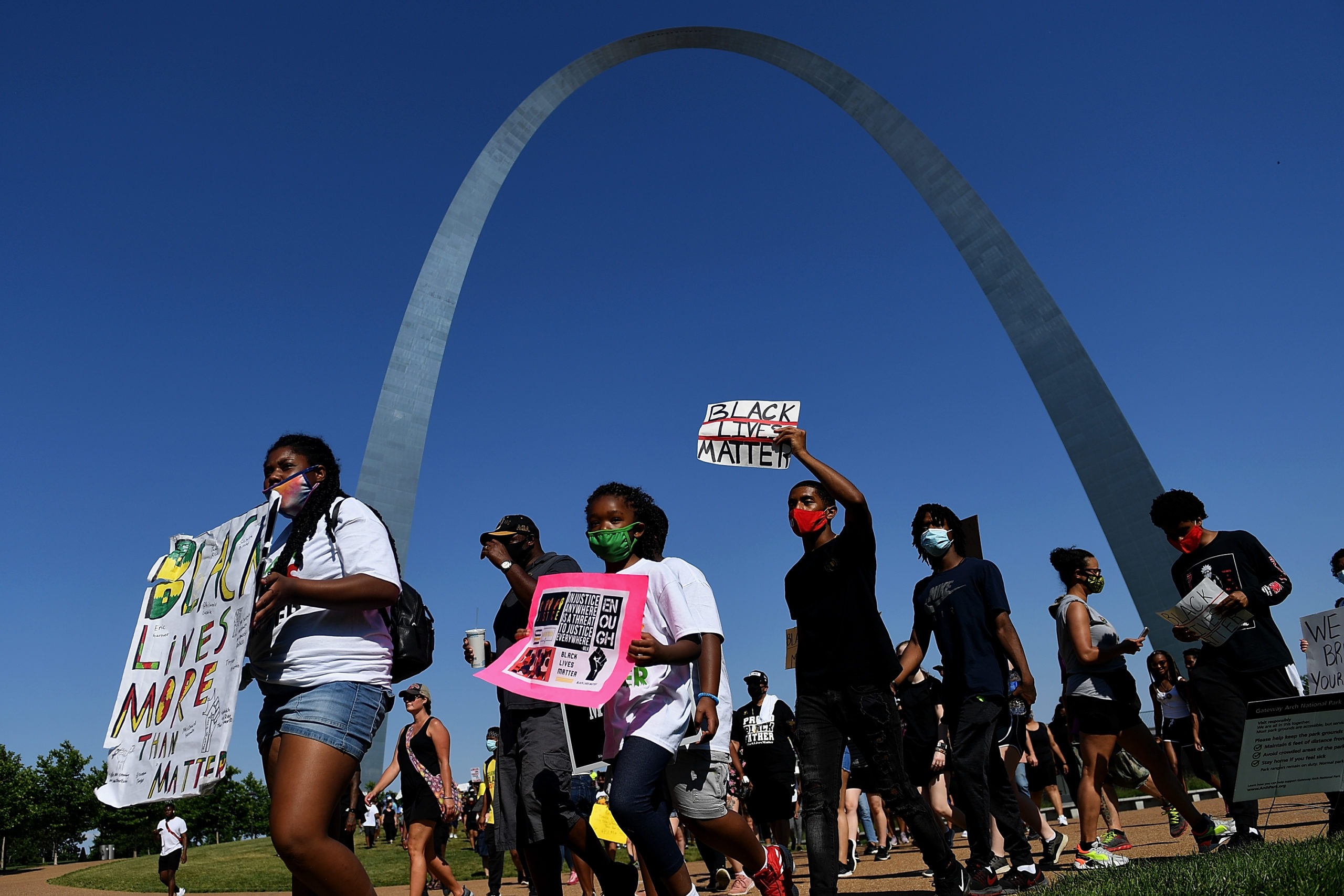Political Report
This Anti-Violence Strategy May Be Coming to St. Louis, but Activists See Red Flags
Both mayoral candidates in tomorrow’s election favor an approach called focused deterrence. Some advocates caution it could reinforce punitive policing.

Both mayoral candidates in tomorrow’s election favor an approach called focused deterrence. Some advocates caution it could reinforce punitive policing.
Last year, 262 people were murdered in St. Louis, bringing the city’s homicide rate higher than it’s been in 50 years. Most of those cases are still open and unsolved. Those figures have made reducing violent crime one of the key issues in the city’s upcoming mayoral election.
Activists have stressed that this shouldn’t mean ramping up policing, but addressing the root causes of violence instead. They’re hoping the next mayor will take an approach to public safety that embraces that vision.
The two candidates on the ballot on Tuesday have both promised some criminal justice reforms. City Treasurer Tishaura Jones and Alderperson Cara Spencer align on several issues like directing some 911 calls to mental health professionals instead of police and closing The Workhouse, one of the city’s notorious jails. Jones has also championed ending cash bail and the decriminalization of sex work.
But both candidates have also laid out plans for a violence prevention model called focused deterrence that runs the risk of becoming yet another punitive law enforcement tool.
This approach identifies people who police suspect are likely to commit violent crime and offers them social services couched in the threat of harsh prosecution if they break the law. Regardless of who wins the mayoral election, a focused deterrence strategy is on St. Louis’s horizon.
“Focused deterrence can end up being very police-heavy and I’ve seen it misused in those ways,” said Antonio Cediel, urban strategies campaign manager at the LIVE FREE Campaign, a faith-based movement to reduce gun violence and end mass incarceration. “I would really caution against simply viewing it as a more ingenious version of tough on crime.”
Focused deterrence strategies operate under the premise that a small number of people in “street groups” are responsible for much of violent crime in a city, and that there are people at risk of committing violence who can avoid it if given the right interventions. The idea is for public authorities to team up with nonprofits and community leaders to identify these individuals and groups. They do that by reviewing data on homicides and nonfatal shootings, information about people in crime-heavy areas who have criminal records, and also details about people in their social networks.
Officials and community leaders then reach out to the groups to deliver a message that Spencer has described as a “carrot and stick.” They offer them tailored services and support, like housing, health services, or job training. But if someone commits violence, law enforcement and other agencies take targeted action against them.
Some criminal justice reform advocates push back against the punitive threats this strategy relies on. As part of a focused deterrence strategy, law enforcement typically crack down not only on people accused of committing violence, but also on other people they are associated with. This can include arresting people on charges for unrelated offenses, and employing non-traditional enforcement actions like checking group members’ car registrations, fining them for housing code violations, or seeking to evict them from public housing.
“We don’t want the rights of people trampled on while draconian measures are put in place,” Johnson Lancaster, a St. Louis resident and a member of the Coalition Against Police Crimes and Repression, told The Appeal: Political Report. Lancaster added that taking a more focused approach to violent crime and offering social services could be promising as long as it doesn’t lead to heavy policing that violates people’s civil liberties.
David Muhammad, who is the executive director of the National Institute for Criminal Justice Reform and has worked with cities across the country to implement violence reduction programs, says most places do not implement focused deterrence well. “It certainly should not be an enforcement-only strategy or enforcement-mostly strategy,” Muhammad told the Political Report. “It’s not carrot and stick. It’s not if you don’t take services you get enforcement. It’s if you continue to engage in gun violence there’s enforcement.” The emphasis, he said, should be on providing social services and involving community members in the decision-making process.
Other St. Louis initiatives aimed at stemming violence have given activists reason to treat focused deterrence with caution. For example, the city rolled out a Cure Violence program last year. It was supposed to involve hiring outreach workers and violence interrupters with strong ties to the community to mediate conflicts and connect people with services. But local activists say city officials ignored input from the community groups that brought the program to the city in the first place.
And in 2017, St. Louis Metropolitan Police Chief John Hayden launched a strategy dubbed “Hayden’s Rectangle,” a form of “hotspot” policing that targets a particular geographic area of the city and increases the police presence in that neighborhood. Hayden measured success based partly on the number of arrests officers made, which flies in the face of the solutions that activists have called for. Lancaster said the city needs “a new vision of public safety that focuses less on arresting, prosecuting, and incarcerating and more on addressing the root causes of crime in communities and building opportunities for these people.”
David Kennedy, a professor of criminal justice at John Jay College of Criminal Justice and the director of the National Network for Safe Communities, is credited with developing some of the first focused deterrence strategies in the United States. He said concerns about focused deterrence are unsurprising, given communities’ past experiences with police. But ultimately, he sees it as a departure from other types of policing strategies that tend to crack down on low-level offenses or target entire neighborhoods.
“People are right to be attentive to and skeptical about really bad criminal justice practices because these communities have forever been over-policed and under-protected,” said Kennedy. “But this is a way to not continue to do the damage that bad policing does.”
Studies have shown that focused deterrence can lead to reductions in gun violence, and proponents like Kennedy often point to Oakland, California, as an example where social services and community engagement have been prioritized over law enforcement.
Oakland got a focused deterrence program called Oakland Ceasefire Strategy up and running in 2013. During the first five years of Ceasefire, gun-related homicides dropped in the city by 45 percent, although in the past year they’ve returned to pre-Ceasefire levels. Oakland’s model has been successful, proponents say, because the city made significant investments in the program by funding positions like outreach workers and life coaches, who make contact with individuals, connect them with services, and maintain a relationship to encourage them to stick with the life changes they are making and avoid violent behavior.
Efforts to reduce violent crime in St. Louis will fail if the focused deterrence strategy cuts corners, said Muhammad. “Some cities will say, ‘Oh we gave them some referrals to service providers.’ That’s not enough. You need to create positions so it’s people’s full-time job to be in contact with the highest-risk guys … there needs to be ongoing, structured, intensive engagement.”
Daniel Webster, director of the center for gun policy and research at the Johns Hopkins Bloomberg School of Public Health, said Baltimore failed to provide robust services and relied too heavily on law enforcement when rolling out a focused deterrence strategy. He said that in Baltimore there was little community involvement and on the city’s part “there was not enough support services and there was no ‘focus’ in the focused deterrence.”
Philadelphia’s focused deterrence strategy included heavy-handed, punitive measures, including turning off the utilities of people’s loved ones in response to shootings.
“I remember once talking to a U.S. attorney who was almost bragging about threatening to shut off the services, like that was some type of heroic move,” said Cediel from LIVE FREE.
Spencer and Jones told the Political Report they would not do this. Jones’s campaign said her strategy “would not use the deprivation of critical resources to St. Louisans to encourage participation.” Spencer said, “Turning off the utilities is often the first step in homelessness. Using that as a threat is not something my administration would do.”
Spencer has repeatedly cited Oakland as a model she would base her administration’s focused deterrence strategy on and said she aims to drive down the city’s homicide rate by 30 percent in her first term if elected. Spencer said although her model would involve law enforcement and prosecutors, hers would not be a heavily punitive program. The city would “partner with agencies that will connect people to the resources they need to turn their lives around,” she explained.
Similarly, Jones said her focused deterrence strategy would involve police and prosecutors, but that would be coupled with other changes Jones seeks to make when it comes to public safety.
“Successfully implementing focused deterrence requires not just concentrated police attention on a small group of citizens, but also authentic relationships with credible prevention workers and robust social services available for those willing to avoid criminal behavior,” Jones’s campaign told the Political Report in an email. “The St. Louis focused deterrence version will integrate critical city services and access to nonprofits to assist with employment, substance abuse, mental health, and other services.”
While groups like the Coalition Against Police Crimes and Repression have yet to take an official position on the strategy, Lancaster sees what happened with the Cure Violence program as a cautionary tale: Although the coalition was involved in the effort to bring Cure Violence to St. Louis, it later bowed out of the initiative, as did others, citing concerns over the way it was being implemented.
“That’s what happens when there’s a disconnect between the will of the people and the folks who implement the policies on a government level,” said Lancaster. “When they’d rather satisfy their political objectives as opposed to carrying out the will of the people. So we hope to avoid that with the next mayoral administration.”
